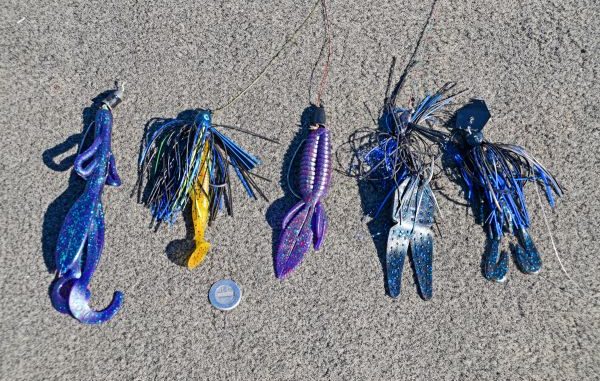
Billy Billeaud fishes four styles of jigs: flipping, bladed, swimming and football models.
While 1/2-ounce is his preferred size, Billeaud will use whatever it takes to penetrate thick cover, even moving up to 1 ½ to 2 ounces.
Favored colors are, in descending order, black and blue; black, brown and amber; and green pumpkin.
Here’s how he chooses the style of lure to use in a given situation:
• Flipping jigs: These are Billeaud’s all-around jigs, good for most conditions around logs, trees, stumps, laydowns and lilies. They are his choice for fishing dense cover.
His bread-and-butter flipping jig is a Falcon Jig made in Lafayette. He fishes these jigs with chunk trailers.
• Bladed jigs: Bladed jigs, also called “chatterbaits” after the first vibrating jig that came out, are good choices for fishing grassy areas. The blade makes the jig vibrate as the lure is fished with a slow steady retrieve.
These jigs are rigged with crawfish or swim bait trailers.
• Swim jigs: The line eyes in these jigs point straight out the front of the jighead rather than being angled upward as with other jigs. It is a jig, but is fished in the same places in which spinnerbaits would be effective.
They are fished with a steady retrieve, and are rigged with a swimbait tail on the hook.
Because of their poor weed guards, they are not a good choice for fishing in wood.
• Football jigs: This jig is named after its football-shaped head. They are a good for fishing rocky, sandy or hard bottoms, and are an excellent choice for fishing in deep water.
Jigs in the past have been considered to be shallow-water lures, but professional fishermen now use them in water as deep as 40 feet. The football-shaped head makes the bait rock back and forth without falling over as it is retrieved.
They are used with trailers — a chunk, a crawfish, or even a worm.
Best rods, reels for Atchafalaya Basin bass fishing
Billy Billeaud doesn’t arm himself lightly for bass fishing in the Atchafalaya Basin.
His rods are all 7- or 7 ½-footers.
His punching rods are extra-heavy models. He also stows on the boat one heavy-action rod spooled with fluorocarbon line for extra-clear water situations.
The rest of his rods are medium action — for a very good reason. With short lines out, his usual fishing situation, and with no-stretch braided line, it’s easy to tear the hook from a fish’s mouth when using stiffer rods.
The bend in a medium-action rod helps prevent that from happening.
A convert from Spectra Lynch Line, Billeaud uses 70-pound-test Diawa Samurai braid. Heavy stuff.
Braided lines are inherently not colorfast, so in a slick trick, Billeaud takes the time to colorize short segments of the faded, light-colored line with black, green and brown Super Sharpie permanent markers. He does this for 2 to 3 feet of line above the jig, effectively creating camouflaged line.
Billeaud uses a variety of reels. Gear ratio is more important to him than brand.
Unless he is using crankbaits, he wants a 6:1 ratio reel.
“I am always in contact with a crankbait,” he explained. “With other baits — even spinners — you have periods of no-contact.
“If the fish is coming toward you with the bait, you need to quickly pick up any slack in the line.”